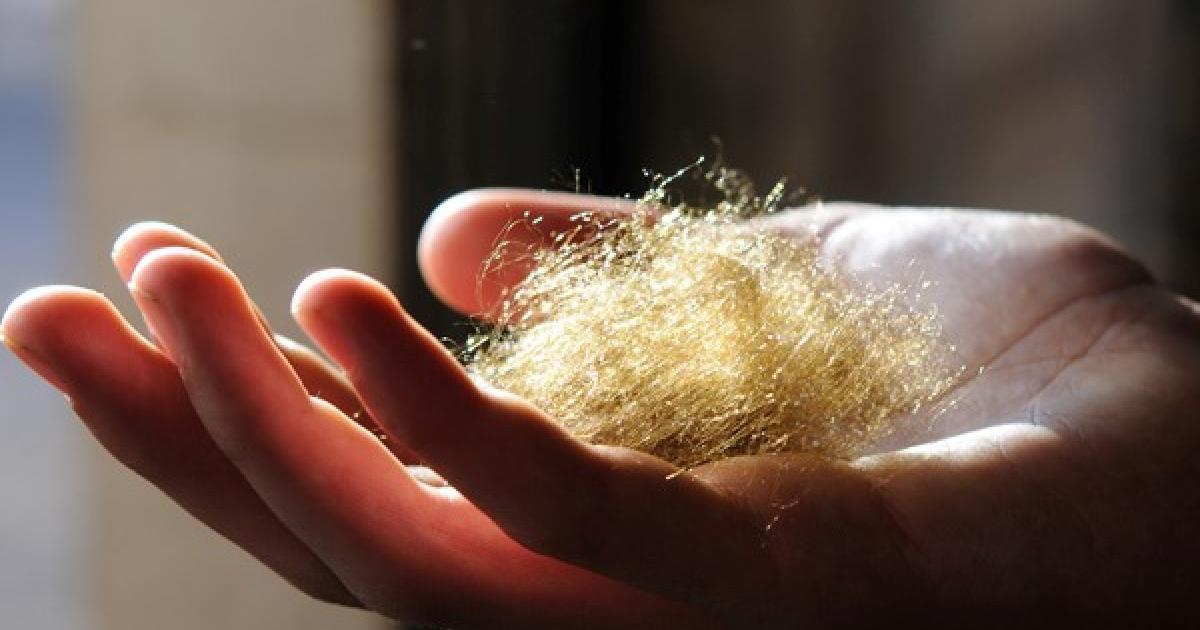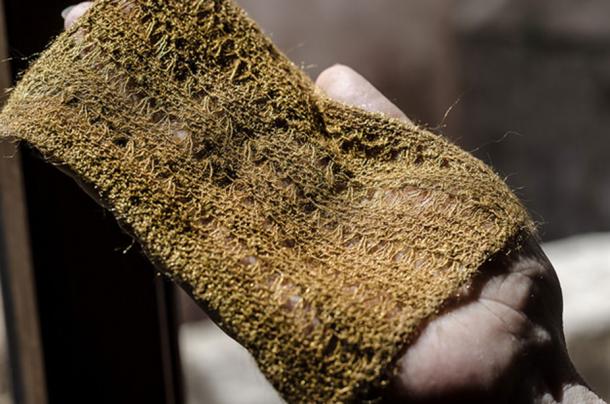
One Person Left on Earth Knows the Ancient Secret of Producing Sea Silk
Sea silk is a highly-precious fabric that is so rare only one woman left on earth knows the secret to its creation. Whilst silk is famously known to be obtained from the cocoons of the mulberry silkworm larvae, sea silk comes from a type of Mediterranean clam known as the pen shell. Like regular silk, sea silk is a luxurious product, but few will ever get to touch, let alone see, this rare fabric. Its creation is a dying art – when master weaver Chiara Vigo passes away, so too will the ancient tradition of producing sea silk.

Pinna nobilis shell and byssus or sea silk (CC BY-SA 3.0)
The production of sea silk is a tradition said to date back to ancient times. To produce this luxurious item, one would first need to harvest the byssus (a bundle of filaments secreted by certain species of bivalves to attach themselves to a solid surface) of the pen shell (in particular, Pinna nobilis, commonly known as ‘noble pen shell’). The byssus then needs to be treated and spun into threads before it can be used for weaving or embroidery. The final result is a material that glistens in the sunlight like gold. This gold-like aspect of sea silk is one of the factors contributing to its popularity amongst the rich and powerful of the ancient world. It may be added that sea silk is also valued for its extremely light nature.
- The Legend of Leizu and the Origins of Luxurious Chinese Silk
- Recent Textile Discovered in Nepal Sheds Light on How Far South the Silk Road Actually Extended

Material produced from sea silk by Chiara Vigo (CC BY-SA 2.0)
Sea silk is said to have been valued by many ancient cultures. The kings of Mesopotamia, for example, are said to have had garments of sea silk made for them. It has also been claimed that sea silk was known to the ancient Egyptians, Romans and Greeks. Moreover, this material may have been mentioned in ancient texts. It has been pointed out, for instance, that in the Old Testament, the word ‘byssus’ appears as many as 45 times. Nevertheless, in some instances, the ‘byssus’ is almost certainly a reference to other types of fabric, for example, cotton, linen, or silk. It has also been suggested that some objects from mythology may actually be sea silk. This, for instance, is an interpretation of the Golden Fleece found in the Greek myth of Jason and the Argonauts.

The Golden Fleece by Herbert James Draper, 1864-1920 (Public Domain)
Returning to modern times, it may be said that the ancient tradition of producing sea silk is almost lost. On the island of Sardinia, a woman by the name of Chiara Vigo is keeping the tradition of sea silk alive. Whilst there are still several women in Apulia reputed to have the knowledge of weaving sea silk, it has been claimed that none of them harvest the raw materials themselves, and that none of them are able to produce fabrics that match the quality of Vigo’s products.
- Egyptian Blue – The Oldest Known Artificial Pigment
- 8,500-year-old Evidence of Silk Production Weaves a New History of the Luxurious Fabric

Chiara Vigo, last master of sea silk manufacture, weaving with sea silk (Guilio Gigante CC BY-SA 2.0)
According to Vigo, the knowledge of sea silk production was brought to Sardinia by Berenice of Cilicia, a member of the Herodian Dynasty, and a great-granddaughter of its founder, Herod the Great. This skill was traditionally handed down from one generation to the next by the women of the family. Vigo, for instance, was taught the art of producing sea silk by her grandmother. Whilst sea silk was produced in the past for the rich and powerful, Vigo weaves this fabric mainly for outcasts, the poor, and the needy. Furthermore, the sea silk made by Vigo is not for sale. It has been reported that in the past, some sea silk weavers have attempted to make a business out of their skill, and to manufacture sea silk on an industrial basis. Such attempts, however, have never succeeded.
- Think Your Blue Jeans Are Faded? Compare Them to This 6000-Year-Old Textile Found in Peru
- Stitching the Story of Cutwork Embroidery, One of the Most Luxurious Goods in Europe

Stocking made of sea silk (byssus) from Pinna nobilis, 1765-1800 AD, in the Naturhistorisches Museum, Braunschweig, Germany. (Public Domain)
Although the production of sea silk is a dying art, Vigo is trying to keep it alive by teaching some people how to weave this material. Additionally, she hopes that her daughter would continue in her footsteps, thus keeping this ancient tradition alive for generations to come.
Top image: Hand holding sea silk. Photo by Luigi Garavaglia
By Wu Mingren
References
Frost, N., 2017. You’ll Probably Never Get to See, Let Alone Touch, Sea Silk. [Online]
Available at: http://www.atlasobscura.com/articles/sea-silk-rarest-thread-italy-clams-textiles-fabric
Maeder, F., 2017. Project Sea-silk. [Online]
Available at: http://www.muschelseide.ch/en/projekt.html
Paradiso, M., 2015. Chiara Vigo: The last woman who makes sea silk. [Online]
Available at: http://www.bbc.com/news/magazine-33691781
Stein, E., 2017. The last surviving sea silk seamstress. [Online]
Available at: http://www.bbc.com/travel/story/20170906-the-last-surviving-sea-silk-seamstress
Sumitra, 2015. Chiara Vigo – The World’s Last “Sea Silk” Seamstress. [Online]
Available at: http://www.odditycentral.com/news/chiara-vigo-the-worlds-last-sea-silk-seamstress.html
Van Huygen, M., 2015. Untangling the Secrets of Sea Silk, the Ancient Mediterranean’s Elusive Luxury Textile. [Online]
Available at: http://mentalfloss.com/article/69654/untangling-secrets-sea-silk-ancient-mediterraneans-elusive-luxury-textile















